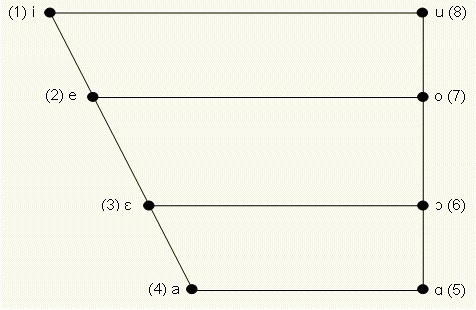


Having discussed the physical reality behind speech sounds, we can now move on towards a more systematic investigation of how these sounds are used in English. As I have already pointed out in the introductory section, this is the point where we progress from a more or less phonetic and very concrete description of the individual sounds towards establishing a more abstract kind of classification. In other words, we – at least temporarily – move on from phonetics to phonology.
Vowels in English exhibit a great and noticable degree of variability. They are also not quite as easy to describe as consonants because we do not have a clearly definable place of articulation to make reference to. This is why we need to have some mechanism(s) for establishing points of reference that are more or less intuitively understandable and as far as possible universally applicable to the description of different vowel qualities or approximate tongue configurations. For English, there are essentially two different established systems of reference, one based on articulatory principles and the other on keywords. We’ll start by discussing the articulatory one as it’s the first one of the two to have been established.
The descriptive system of the Cardinal Vowels was developed by the British Phonetician Daniel Jones. The term cardinal here is used in analogy to the cardinal points on the compass. The cardinal reference points in Jones’ system refer to the points of maximal open/closedness or front/backness with respect to the four ‘corners’ of the vowel chart. For example, if one increased the degree of closeness for cardinal number 1 (or C1) any further, one would end up producing a semi-vowel /j/ instead; conversely, increasing the degree of backness for C5, we would eventually end up producing the uvular fricative /ʁ/ that may be familiar to you as the general realisation of the grapheme <r> for French or for some Northern accents of German. Apart from these four extreme points, there are four intermediate reference points at roughly equal distance from cardinals 1 & 4 and 5 & 8 respectively, as can be seen from the chart of primary cardinal vowels below. One important feature of this primary set is that the degree of lip rounding increases steadily from C1 to C8.

It is often claimed that it is impossible to learn how to produce the cardinal vowels without a teacher who knows them, maybe because Jones himself claimed this. However, this seems an odd claim because there should really be no reason for someone with a reasonable amount of pronunciation training not to be able to produce these sounds, especially in light of the fact that the realisations of the experts themselves do not absolutely correspond to one another. In order to get an illustration of this, you can compare the two different realisations found at the following links, one by Jones himself and the other by Peter Ladefoged . If you listen to the two renditions carefully, you should be able to hear some clear differences, especially in the realisation of C4, where Jones’ own example does not quite seem to ‘hit the target’.
As my explicit reference to the term primary cardinal vowels has probably already made clear, there is also a set of secondary cardinal vowels. These, however, are less relevant for our purposes since they specify phoneme qualities that do not occur in the reference accents we’re currently interested in, although they may well become relevant for the analysis and description of individual accents later. The main distinction between the two sets is that, although the secondary cardinals occupy the same positions at the primary ones, their degree of lip rounding is exactly opposite to them.
Once we have a pretty good idea of what the cardinal vowels sound like and where they are produced, we can use them as reference points for describing vowels in different varieties of English or other languages. Thus, for example, we could describe the RP realisation of /iː/ as being similar to C1, but slighly more open and central, whereas the realisation of /ɪ/ could be characterised as being approximately half-way between C1 and C2 in terms of openness. And in order to describe the difference in the realisation of the /uː/ phoneme in English and German, we can say that the average German realisation tends to be much closer to C8 than it is the case for English.
The basic idea behind using lexical sets is to have a number of reference key words that remain fairly stable across a number of different accents. This may make it somewhat easier to compare different accents than if one has to refer to more ‘abstract’ entities, such as cardinal vowels. The table below lists the keywords for each set and their corresponding values for RP and GenAm respectively, as far as possible incorporating more recent changes in the reference accents in comparison to John Wells’ original table.
Jones, D. (1972). An Outline of English Phonetics (9th ed.). Cambridge: W. Heffer & Sons Ltd.
Wells, J.C. (1982). Accents of English. Vols. 1 & 2. Cambridge:CUP.